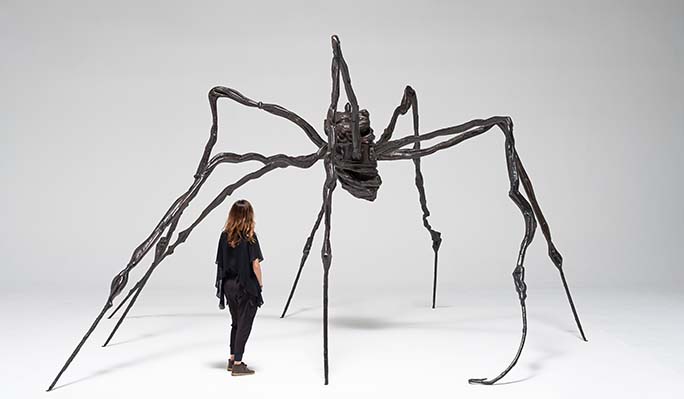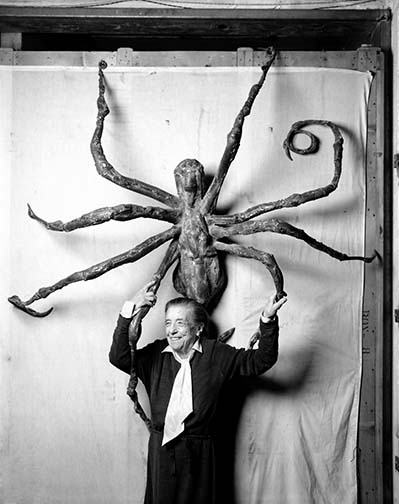루이스 부르주아 '거미' 여성작가 최고가 3천280만 달러 경매
조각가 루이스 부르주아의 대형 조각 '거미(Spider)'가 18일 뉴욕 소더비에서 여성작가 사상 최고가인 3천280만 달러에 경매됐다. <Update>

뉴욕 소더비 루이스 부르주아 조각 '거미' 경매, 예상가 3천-4천만 달러
뉴욕 소더비가 오는 5월 18일 프랑스 출신 조각가 루이스 부르주아(Louise Bourgeois, 1911-2010)의 대작 '거미(Spider), 1996'를 경매한다. 예상가는 3천만-4천만 달러. 이전 회고의 부르주아 작품은 2019년 크리스티 뉴욕에서 3천210만 달러에 팔린 '거미(1997)'다. 뉴욕 소더비(1334 York Ave, New York)는 5월 6일부터 18일까지 '거미'를 전시하며, 경매는 18일 오후 7시에 열린다.
*루이스 부르주아: 이 세상의 어머니(Maman)들을 위하여
https://www.nyculturebeat.com/?mid=Art2&document_srl=4068188
Louise Bourgeois' Monumental 'Spider' to Make Auction Debut at Sotheby's
this May | Est. $30-40m
EXHIBITION: New York: 6 — 18 May
AUCTION: Contemporary Evening Auction, Thursday, May 18 7PM EST
NEW YORK, 24 April 2023 – At once beautiful and haunting, familiar and uncanny, Louise Bourgeois’ monumental Spiders stand among the most entrancing and ambitious artistic achievements of the twentieth century. Hailing from the apex of Bourgeois’ mature practice, the poignant series serves as a testament to the enduring appeal of the artist, capturing the most fundamental human emotions — love and fear — in sculptural form. Her most widely recognizable and renowned body of work, Bourgeois’ monumental Spiders are today key highlights of the most prestigious museum and private collections all over the world.
This May, Sotheby’s will offer Spider from 1996 - an early and profoundly significant example of Bourgeois’ most iconic motif, and one of just four monumental Spiders to ever appear at auction.1 A cast of this Spider has not appeared at auction in over a decade, with other editions of this cast held in the National Gallery of Art, Washington, D.C., and Kemper Museum of Contemporary Art, Kansas City, Missouri.
Creating a reverential awe to all who approach, Spider soars over 10 feet tall and measures more than 18 feet across, its imposing scale evoking the experience of a child looking up at their mother in adoration. Bourgeois imbues her spellbinding arachnids with deeply personal memories of her childhood; their delicate legs and needle-like forms hold memories of her own mother, a skilled tapestry weaver and restorer whose death deeply affected the artist. Encapsulating the artist’s contradictory associations with motherhood, the spider represents both a formidable predator and an industrial repairer and protectress, exquisite yet severe. The artist’s most poignant symbol, her Spiders are both universal and deeply personal, as Bourgeois draws upon to articulate the shared, infinitely complex experience of motherhood.
The sculpture emerges from the Fundação Itaú, having remained in the prestigious institutions’ collection in São Paulo for more than two decades. The Fundação Itaú acquired the sculpture in 1996 - the year of the work’s execution - after it was featured at the 23rd Biennial de São Paulo in a dedicated salon of the artist’s work. The artist also designed the logo of the 1996 Biennial, an intricate spiral design that recalls both a web and the spiraling core of her Spider.
While this sculpture was an early, core component of the Fundação Itaú collection when it was acquired more than 25 years ago by Olavo Setubal – art collector and one of the founders of Itaú Unibanco -— the Fundação now primarily focuses on collecting and promoting works by artists based in Brazil. Dedicated to initiatives in culture, education, and health in Brazil, funds raised from the sale of the work will be fully allocated to strengthening the structure and continuity of Itaú Cultural. Formed as part of Banco Itaú’s long tradition of investing in arts and culture, Itaú Cultural was created 35 years ago to channel its initiatives in these fields. Overseen by the Fundação Itaú, Itaú Cultural offers extensive free cultural programming including exhibitions, plays, attractions for children and more at its headquarters in São Paulo and throughout Brazil, in partnership with other institutions. See below for more information on Itaú Cultural and its impact on the arts and culture in Brazil.

Louise Bourgeois photographed with Spider IV, 1996. Image © Peter Bellamy. Art © The Easton Foundation
The artist’s signature and most iconic motif, Bourgeois’ Spider represents a surrogate for a maternal figure, serving as a stand-in for her own mother, Joséphine, who was a skilled tapestry weaver. Contemplative and methodical, weaving tapestries was a cherished and tender act shared between Bourgeois and her mother. Her mother’s death in 1932 was a trauma that informed the entirety of Bourgeois’ artistic practice, as she sought to negotiate that loss and their relationship through her sculptural creations.
Bourgeois first imagined her Spiders in early drawings dating back to 1947, and subsequently translated her signature theme into momentous and revelatory sculptural form in the mid-1990s; during this period, her sculptures matured rapidly, spanning greater scales and becoming increasingly intricate and technically complex Consumed by the theme, the artist simultaneously published a poem titled Ode à ma mère alongside a suite of nine etchings, attesting to the significance of the spider as a maternal figure. Drawing upon a remarkably diverse selection of artistic influences ranging from Surrealism to Modern Art, Alberto Giacometti to Barnett Newman, Bourgeois’ illustrious arachnids have undeniably revolutionized the course of Post War sculpture. Today, these sculptures stand alongside such iconic sculptures as Giacometti’s Walking Man, Brancusi’s Mademoiselle Pogany, and even the Nike of Samothrace, representing Bourgeois’ most important contribution to art history and the sculptural canon.
Assuming command of its surroundings, Spider’s arched legs reach towards its prey as another delicately curls towards itself, as if it is ready to strike, while simultaneously beckoning the viewer. Recurring throughout the artist’s oeuvre, the spiral of the spider’s body – echoed in Bourgeois’ iconic logo for the 23rd Sao Paulo biennale – represents “an attempt at controlling chaos” as explained by the artist.4 Preventing disease by devouring mosquitoes, the arachnid inspired Bourgeois, representing both a sinister predator and a fierce protectress. Having experienced motherhood herself, Bourgeois’ monumental Spiders navigate her complex feelings toward motherhood, negotiating the divide between the dualities of the self and the universal, nurture and destruction, love and abandonment. This tension, between allure and anxiety, reflects the concerns at the very heart of Bourgeois’s artistic project: an unflinching investigation of the human experience and psyche, translated into sculptural form.
1. A Spider from 1996 was sold at Christie’s New York in May 2019 for $32.1 million (est. $25-35 million) – the current auction record for a work by the artist.
2. Itaú Cultural also supports the Rumos Program, which provides financing for a variety of projects spotlighting emerging artists in Brazil. The Itaú Cultural Observatory produces vital studies and data on the economy of culture and creative industries in Brazil, offering subsidies for managers and the formulation of public policies in this area. The institution additionally develops a series of training programs ranging from free courses to postgraduate programs in conjunction with important institutions of higher education. In addition to these initiatives, Banco Itaú is a sponsor of major cultural institutions in Brazil, including MASP (Museum of Art of São Paulo), MAM (Museum of Modern Art of São Paulo), Bienal de São Paulo, Pinacoteca do Estado de São Paulo, among others.
3. The current world auction record for any female artist is $44.4 million for Georgia O’Keeffe’s Jimson Weed/White Flower No. 1, sold at Sotheby’s in 2014.
4. The artist quoted in Marie-Laure Bernadac and Hans-Ulrich Obrist (eds), Louise Bourgeois: Destruction of the Father, Reconstruction of the Father, London 1998, pp. 222-223.





 마크 로스코 자녀 케이트, 크리스토퍼와의 대화 @아니타로저스 갤...
마크 로스코 자녀 케이트, 크리스토퍼와의 대화 @아니타로저스 갤...

